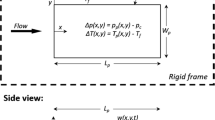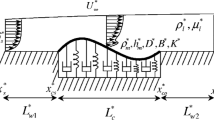Abstract
Sustained flight at hypersonic speeds is characterized by high pressure and aerothermal loads imposed on the structure of the aerodynamic vehicle. A consequence of lightening the structural design permits fluid–structure interaction phenomena that can significantly alter the flow and initiate unsteady structural responses. We investigate the coupling between high-speed laminar boundary layer flows over a mechanically compliant panel and analyze the dynamic system response of the coupled system to boundary layer instabilities by means of local convective linear stability analysis. The resulting non-dimensional interaction parameters describing the compliant system are shown to affect the boundary layer instabilities in the infinitely thin panel limit, and the transition from the rigid limit is described by two distinctly different responses: (a) a piston-like, one-dimensional panel deflection, or (b) a synchronization with flexural waves. Compliance is shown to non-monotonically change convective wave growth rates and induce uncertainty in the integrated N-factors.








Similar content being viewed by others
References
Gray, J.: Studies in animal locomotion: VI. The propulsive powers of the dolphin. J. Exp. Biol. 13(2), 192–199 (1936)
Kramer, M.O.: Boundary layer stabilization by distributed dam**. J. Am. Soc. Nav. Eng. 72(1), 25–34 (1960)
Benjamin, T.B.: Effects of a flexible boundary on hydrodynamic stability. J. Fluid Mech. 9(4), 513–532 (1960)
Landahl, M.T.: On the stability of a laminar incompressible boundary layer over a flexible surface. J. Fluid Mech. 13(4), 609–632 (1962)
Benjamin, T.B.: The threefold classification of unstable disturbances in flexible surfaces bounding inviscid flows. J. Fluid Mech. 16(3), 436–450 (1963)
Carpenter, P.W., Garrad, A.D.: The hydrodynamic stability of flow over Kramer-type compliant surfaces. Part 1. Tollmien–Schlichting instabilities. J. Fluid Mech. 155, 465–510 (1985)
Carpenter, P.W., Garrad, A.D.: The hydrodynamic stability of flow over Kramer-type compliant surfaces. Part 2. Flow-induced surface instabilities. J. Fluid Mech. 170, 199–232 (1986)
Davies, C., Carpenter, P.W.: Instabilities in a plane channel flow between compliant walls. J. Fluid Mech. 352, 205–243 (1997)
Malik, M., Skote, M., Bouffanais, R.: Growth mechanisms of perturbations in boundary layers over a compliant wall. Phys. Rev. Fluids 3(1), 013903 (2018)
Dugundji, J: Theoretical considerations of panel flutter at high supersonic mach numbers. AIAA J. 4(7), 1257–1266 (1966)
Eirikur J., Cristina R., Christopher A.L., Carlos E.S.C., Joaquim R.R.A.M., Bogdan I.: Epureanu. Flutter and post-flutter constraints in aircraft design optimization. Prog. Aerosp. Sci. (2019)
Dowell, E.H., Hall, K.C.: Modeling of fluid-structure interaction. Annu. Rev. Fluid Mech. 33(1), 445–490 (2001)
Salvatore, L., George, T.: Identification of knowledge gaps in the predictive capability for response and life prediction of hypersonic vehicle structures. In: 52nd AIAA/ASME/ASCE/AHS/ASC structures, structural dynamics and materials conference 19th AIAA/ASME/AHS adaptive structures conference 13t, p. 1961 (2011)
Brian, Z., Shelby, H., Macguire, J., McAuliffe, P.: Investigation of shortfalls in hypersonic vehicle structure combined environment analysis capability. In: 52nd AIAA/ASME/ASCE/AHS/ASC structures, structural dynamics and materials conference 19th AIAA/ASME/AHS adaptive structures conference 13t, p. 2013 (2011)
Bondarev, V., Vedeneev, V.: Short-wave instability of an elastic plate in supersonic flow in the presence of the boundary layer. J. Fluid Mech. 802, 528–552 (2016)
Sucheendran, M.M., Bodony, D.J., Geubelle, P.H.: Coupled structural-acoustic response of a duct-mounted elastic plate with grazing flow. AIAA J. 52(1), 178–194 (2013)
Bountin, D., Chimitov, T., Maslov, A., Novikov, A., Egorov, I., Fedorov, A., Utyuzhnikov, S.: Stabilization of a hypersonic boundary layer using a wavy surface. AIAA J. 51(5), 1203–1210 (2013)
Zachary, B.R., Jack, J.M.: Interaction between aerothermally compliant structures and boundary layer transition in hypersonic flow. In: 15th Dynamics Specialists Conference, p. 1087 (2016)
Ostoich, C.M., Bodony, D.J., Geubelle, P.H.: Interaction of a Mach 2.25 turbulent boundary layer with a fluttering panel using direct numerical simulation. Phys. Fluids 25(11), 110806 (2013)
Huang, D., Friedmann, P.P.: An aerothermoelastic analysis framework with reduced-order modeling applied to composite panels in hypersonic flows. J. Fluids Struct. 94, 102927 (2020)
Boyer, N.R., McNamara, J.J., Gaitonde, D.V., Barnes, C.J., Visbal, M.R.: Features of panel flutter response to shock boundary layer interactions. J. Fluids Struct. 101, 103207 (2021)
Freydin, M., Dowell, E.H., Whalen, T.J., Laurence, S.J.: A theoretical computational model of a plate in hypersonic flow. J. Fluids Struct. 93, 102858 (2020)
Malik, M.R.: Numerical methods for hypersonic boundary layer stability. J. Comput. Phys.86(2), 376–413 (1990)
Mack, L.M.: Special course on stability and transition of laminar flow. AGARD Report, 709 (1984)
Malik, M.R.: Prediction and control of transition in supersonic and hypersonic boundary layers. AIAA J. 27(11), 1487–1493 (1989)
Fasel, H., Konzelmann, U.: Non-parallel stability of a flat-plate boundary layer using the complete Navier–Stokes equations. J. Fluid Mech. 221, 311–347 (1990)
Hanifi, A., Henningson, D., Hein, S., Bertolotti, F.P., Simen, M.: Linear nonlocal instability analysis—the linear Nolot code. FFA TN 54, 1994 (1994)
Marxen, O., Iaccarino, G., Shaqfeh, E.S.G.: Disturbance evolution in a mach 4.8 boundary layer with two-dimensional roughness-induced separation and shock. J. Fluid Mech. 648, 435–469 (2010)
Dowell, E.H.: A Modern Course in Aeroelasticity. Springer, Berlin (2015)
Acknowledgements
This material is based upon work supported by the Air Force Office of Scientific Research under Award Number FA9550-18-1-0035.
Author information
Authors and Affiliations
Corresponding author
Additional information
Communicated by Pino Martin.
Publisher's Note
Springer Nature remains neutral with regard to jurisdictional claims in published maps and institutional affiliations.
Eigenvalue problem
Eigenvalue problem
The quadratic eigenvalue problem described in Eq. 5 can be rewritten as a first-order system following
where I denotes the identity matrix and 0 is a zero matrix. Similarly, the quartic eigenvalue problem for the compliant system can be rewritten as a first-order system following
The components to the submatrices \([L^0,L^1,L^2,L^4]\) follow the pattern
with the following nonzero components:
where \(D_1\) and \(D_2\) denote the discrete first and second derivative operator with respect to wall-normal coordinate y and \(l_i = i + k/\mu \). These submatrices arise from sorting the governing perturbation equations (Eqs. 1–3 in conjunction with the perturbation ansatz Eq. 4) in the following order:
In terms of the boundary conditions of the rigid system, we enforce \([{\hat{u}}_w, {\hat{u}}_{\infty }]=0\) in the x-momentum equation, \([{\hat{v}}_w, {\hat{v}}_{\infty }]=0\) in the y-momentum equation, \([{\hat{w}}_w, {\hat{w}}_{\infty }]=0\) in the z-momentum equation, and \([{\hat{T}}_w, {\hat{T}}_{\infty }]=0\) in the energy equation. For the compliant system, we substitute \([{\hat{v}}_w, {\hat{v}}_{\infty }]=0\) with Eq. 10, which changes the following components of above submatrices \(L^i\) at the wall:
Rights and permissions
About this article
Cite this article
Dettenrieder, F., Bodony, D.J. Stability analyses of compressible flat plate boundary layer flow over a mechanically compliant wall. Theor. Comput. Fluid Dyn. 36, 141–153 (2022). https://doi.org/10.1007/s00162-021-00600-z
Received:
Accepted:
Published:
Issue Date:
DOI: https://doi.org/10.1007/s00162-021-00600-z




